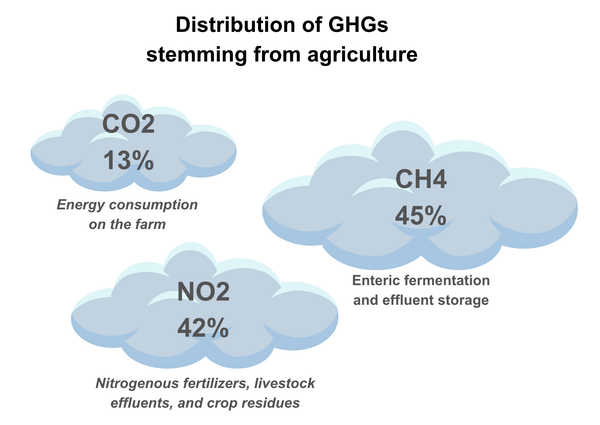
<aside> 📌 Last updated September 18th, 2024.
</aside>
<aside> ⏱️ This article introduces key notions and definitions to understand the main factors of Agricultural impact on climate. Estimated Read Time: 5 minutes
</aside>
Greenhouse gases (GHGs) are gases present in the Earth's atmosphere that absorb and emit radiation within the infrared thermal spectrum. This leads to the phenomenon known as the greenhouse effect, which contributes to warming the Earth's surface.
Some GHGs have natural origins (for example, water vapor or carbon dioxide) or result from human activities (such as fluorinated gases). It's possible for them to originate from both.
The main greenhouse gases (GHGs) are carbon dioxide (CO2), methane (CH4), nitrous oxide (N2O), and fluorinated gases. CO2 is typically the most significant in terms of volume and impact. They are emitted by both natural processes and human activities. Anthropogenic emissions mainly stem from the combustion of fossil fuels, agriculture, deforestation, and industrial activity.
Water vapor is also considered a greenhouse gas. It absorbs and emits infrared radiation, contributing to the warming of the atmosphere. It is unique among greenhouse gases because its concentration is closely tied to temperature. Warmer air can hold more water vapor, which can then amplify the climate changes caused by other greenhouse gases such as CO2.
The Global Warming Potential (GWP) is a measure that compares the ability of each greenhouse gas (GHG) to trap heat in the atmosphere over a given period of time, often 100 years.
GWP is expressed proportionately to CO2, which has a defined GWP of 1. Therefore, a GHG with a GWP of 20 has 20 times the warming effect over a 100-year period compared to CO2.
GWP takes into account the gas's lifetime in the atmosphere and its effectiveness at trapping heat. Some gases have a much greater warming effect than CO2 but may remain in the atmosphere for a shorter time, which is also considered in calculating their GWP.
Here are some GWP values for different GHGs, according to the Intergovernmental Panel on Climate Change (IPCC):
Note that these values may vary slightly depending on methodologies - fluorinated gases, in particular, encompass many different compounds with highly varied GWPs.
The unit "CO2eq" refers to "carbon dioxide equivalents." It consolidates emissions from different greenhouse gases into a sigle unified measure, facilitating analysis, comparison, regulation, and emission reduction efforts. Emissions are converted into an equivalent number of CO2 emissions based on their GWP.
Greenhouse gas emissions related to our diet mainly come from agriculture. They break down as follows: agriculture accounts for 61%, followed by manufacturing industry at 16%, energy industry and extractive activities at 11%, and finally services at 8% (source: ADEME).
It is estimated that agriculture emitted 19% of France's greenhouse gas emissions in 2019, making it the second largest source of national emissions.
The relationship between agriculture and climate change is not limited to greenhouse gas emissions from agricultural activities. Agriculture in itself is particularly vulnerable to the effects of climate change. Agricultural production can be heavily affected by extreme weather events, the emergence of new diseases, constraints on water resources, etc.
The greenhouse gas emissions from agriculture do not primarily originate from energy - they are predominantly composed of molecules other than CO2 and stem from biological processes.

📌 Source: CITEPA, Secten National Report 2022
Livestock animals, particularly ruminants (cattle, sheep, and goats), are characterized by a particular digestive process that causes them to emit CH4 (enteric fermentation) through belching. These emissions are notably influenced by the animal species (cattle being the highest emitters with an average of 62 kg of CH4 per year per head) and the animals' diet. The management (as manure or slurry) of animal excrement, which is rich in organic matter, also emits CH4 during fermentation. In 2018, enteric fermentation accounted for 61% of France's total CH4 emissions, compared to 7% for excrement management. Cattle are responsible for 87% of CH4 emissions associated with livestock.
Nitrous oxide emissions occur directly following the application of nitrogen inputs (direct emissions) or are emitted as part of biological processes related to soil nitrification/denitrification phenomena in cultivated soils (indirect emissions).
Only anthropogenic N2O emissions are considered (resulting from the increase in net nitrogen quantities in managed soils due to human activities), thus generated by the spreading of mineral and organic fertilizers, excretions in pastures, decomposition of crop residues, spreading of sludge, and composts.
Animal excretions also contribute, albeit to a lesser extent, to N2O emissions.
In general, CO2 emissions in the agricultural sector are closely linked to: